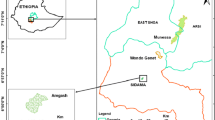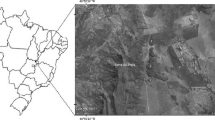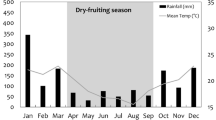Abstract
Behavioral and dietary flexibility permits primates to survive in variable environments. It is clear that some species cope with habitat disturbance and fragmentation better than others. I examined the dietary flexibility of Colobus angolensis palliatus by studying three groups inhabiting structurally distinct ranges in Kenya’s Diani Forest. I predicted that the two groups inhabiting more disturbed areas would have reduced food availability and would respond by increasing dietary diversity and consuming greater proportions of lianas and exotic plant species compared to the group inhabiting the more intact area. Forest composition and overall plant part availability differed among home ranges; however, group diets did not differ in their proportions of different plant parts, nor did groups select plant parts in proportion to their availability. Diets differed dramatically with regard to species-specific plant parts, i.e., mean monthly dietary overlap among groups = 10.4%. Contrary to my predictions, all three groups exhibited considerable dietary diversity, i.e., 63–76 plant species, and relied heavily on lianas, i.e., 20.8–38.4% of the diet, and exotic plant species, i.e., 30.1–40.3% of the diet. The presence of exotic plant species in all three ranges suggests that even the most intact areas of the Diani Forest are perturbed and should be classified along a spectrum of habitat disturbance rather than intact vs. degraded. Nonetheless, this study emphasizes that diets can vary considerably among groups living in the same forest, and this degree of dietary flexibility likely enables C. a. palliatus to survive within increasingly disturbed habitats.


Similar content being viewed by others
References
Altmann, J. (1974). Observational study of behavior: Sampling methods. Behaviour, 49, 227–267.
Anderson, J., Cowlishaw, G., & Rowcliffe, J. M. (2007a). Effects of forest fragmentation on the abundance of Colobus angolensis palliatus in Kenya’s coastal forests. International Journal of Primatology, 28, 637–655.
Anderson, J., Rowcliffe, J. M., & Cowlishaw, G. (2007b). Does the matrix matter? A forest primate in a complex agricultural landscape. Biological Conservation, 135, 212–222.
Anderson, J., Rowcliffe, J. M., & Cowlishaw, G. (2007c). The Angola black and white colobus (Colobus angolensis palliatus) in Kenya: Historical range contraction and current conservation status. American Journal of Primatology, 69, 664–680.
Aristizabal, J. F., Rothman, J. M., Garcia-Feria, L. M., & Serio-Silva, J. C. (2016). Contrasting time-based and weight-based estimates of protein and energy intake of black howler monkeys (Alouatta pigra). American Journal of Primatology. doi:10.1002/ajp.22611.
Bicca-Marques, J. C. (2003). How do howler monkeys cope with habitat fragmentation? In L. K. Marsh (Ed.), Primates in fragments: Ecology and conservation (pp. 283–303). New York: Kluwer Academic/Plenum.
Bicca-Marques, J. C., & Calegaro-Marques, C. (1994). Exotic plant species can serve as staple food sources for wild howler populations. Folia Primatologica, 63, 209–211.
Bocian, C. M. (1997). Niche separation of black-and-white colobus (Colobus angolensis and C. guereza) in the Ituri forest. Ph.D. thesis. New York: City 0055niversity of New York.
Bridgett, G. R., Corriveau, A., & Teichroeb, J. A. (2016). The immediate impact of selective logging on Angolan colobus at Lake Nabugabo. Chicago: Uganda. Podium presentation International Primatological Society Congress.
Brugière, D. (1998). Population size of the black colobus monkey Colobus satanas and the impact of logging in the Lopé Reserve, Central Gabon. Biological Conservation, 86, 15–20.
Buzzard, P. J. (2006). Ranging patterns in relation to seasonality and frugivory among Cercopithecus campbelli, C. petaurista, and C. diana in the tai Forest. International Journal of Primatology, 27, 559–573.
Chapman, C. A., & Chapman, L. J. (1999). Implications of small scale variation in ecological conditions for the diet and density of red colobus monkeys. Primates, 40, 215–231.
Chapman, C. A., & Chapman, L. J. (2000). Constraints on group size in red colobus and red- tailed guenons: Examining the generality of the ecological constraints model. International Journal of Primatology, 21, 565–585.
Chapman, C. A., Balcomb, S. R., Gillespie, T., Skorupa, J., & Struhsaker, T. T. (2000). Long- term effects of logging on African primate communities: A 28 year comparison from Kibale National Park, Uganda. Conservation Biology, 14, 207–217.
Chapman, C. A., Chapman, L. J., Bjorndal, K. A., & Onderdonk, D. A. (2002a). Application of protein-to-fiber ratios to predict colobine abundance on different spatial scales. International Journal of Primatology, 23, 283–310.
Chapman, C. A., Chapman, L. J., Gautier-Hion, A., Lambert, J. E., Rode, K., et al (2002b). Variation in the diet of Cercopithecus monkeys: Differences within forests, among forests, and across species. In M. Glenn & M. Cords (Eds.), The guenons: Diversity and adaptation in African monkeys (pp. 303–317). New York: Kluwer Academic Press.
Chapman, C. A., Chapman, L. J., & Gillespie, T. R. (2002c). Scale issues in the study of primate foraging: Red colobus of Kibale National Park. American Journal of Physical Anthropology, 117, 349–363.
Chapman, C. A., Saj, T. L., & Snaith, T. V. (2007). Temporal dynamics of nutrition, parasitism, and stress in colobus monkeys: Implications for population regulation and conservation. American Journal of Physical Anthropology, 134, 240–250.
Chapman, C. A., Struhsaker, T. T., Skorupa, J. P., Snaith, T. V., & Rothman, J. M. (2010). Understanding longterm primate community dynamics: Implications of forest change. Ecological Applications, 20, 179–191.
Chapman, C. A., Ghai, R. R., Jacob, A. L., Koojo, S. M., Reyna Hurtado, R., et al (2013). Going, going, gone: A 15-year history of the decline of primates in forest fragments near Kibale National Park, Uganda. In L. K. Marsh & C. A. Chapman (Eds.), Primates in fragments: Complexity and resilience (pp. 89–100). Developments in primatology: Progress and prospects. New York: Springer Science+Business Media.
Chaves, O. M., & Bicca-Marques, J. C. (2013). Dietary flexibility of the brown howler monkey throughout its geographic distribution. American Journal of Primatology, 75, 16–29.
Cohen, J. (2013). Statistical power analysis for the behavioral sciences. Hillsdale: Lawrence Erlbaum.
Cords, M. (1987). Mixed species association of Cercopithecus monkeys in the Kakamega Forest, Kenya. University of California Publications in Zoology, 117, 1–109.
Dasilva, G. L. (1992). The western black-and-white colobus as a low-energy strategist: Activity budgets, energy expenditure, and energy intake. Journal of Animal Ecology, 61, 79–91.
Dasilva, G. L. (1994). Diet of Colobus polykomos on Tiwai Island: Selection of food in relation to its seasonal abundance and nutritional quality. International Journal of Primatology, 15, 655–680.
Decker, B. S. (1994). Effects of habitat disturbance on the behavioral ecology and demographics of the Tana River red colobus (Colobus badius rufomitratus). International Journal of Primatology, 15, 703–737.
DeWalt, S. J., Schnitzer, S. A., & Denslow, J. S. (2000). Density and diversity of lianas along a chronosequence in central Panamanian lowland forest. Journal of Tropical Ecology, 16, 1–9.
Dunham, N. T. (2015). Ontogeny of positional behavior and support use among Colobus angolensis palliatus of the Diani Forest, Kenya. Primates, 56, 183–192.
Dunham, N. T., & McGraw, W. S. (2014). Positional behavior and habitat use of Peters’ Angola black and white colobus monkey (Colobus angolensis palliatus) in structurally distinct areas of the Diani Forest, Kenya. African Primates, 9, 1–14.
Dunn, J. C., Asensio, N., Arroyo-Rodríguez, V., Schnitzer, S., & Cristóbal-Azkarate, J. (2012). The ranging costs of a fallback food: Liana consumption supplements diet but increases foraging effort in howler monkeys. Biotropica, 44, 704–714.
Eppley, T. M., Donati, G., Ramanamanjato, J.-B., Randriatafika, F., Andriamandimbiarisoa, L. N., et al (2015). The use of an invasive species habitat by a small folivorous primate: Implications for conservation. PloS One, 10, e0140981.
Fashing, P. J. (2001). Feeding ecology of guerezas in the Kakamega Forest, Kenya: The importance of Moraceae fruit in their diet. International Journal of Primatology, 22, 579–609.
Fashing, P. J. (2011). African colobine monkeys. In C. J. Campbell, A. Fuentes, K. C. MacKinnon, S. K. Bearder, & R. M. Stumpf (Eds.), Primates in perspective (pp. 203–209). Oxford: Oxford University Press.
Fashing, P. J., Mulindahabi, F., Gakima, J., Masozera, M., Mununura, I., et al (2007). Activity and ranging patterns of Colobus angolensis ruwenzorii in Nyungwe Forest, Rwanda: Possible costs of large group size. International Journal of Primatology, 28, 529–550.
Felton, A. M., Felton, A., Lindenmayer, D. B., & Foley, W. J. (2009a). Nutritional goals of wild primates. Functional Ecology, 23, 70–78.
Fimbel, C., Vedder, A., Dierenfeld, E., & Mulindahabi, F. (2001). An ecological basis for large group size in Colobus angolensis in the Nyungwe Forest, Rwanda. African Journal of Ecology, 39, 83–92.
Fretwell, S. D., & Lucas, H. L. (1969). On territorial behavior and other factors influencing habitat distribution in birds. 1. Theoretical development. Acta Biotheoretica, 19, 16–36.
Galat-Luong, A., & Galat, G. (2005). Conservation and survival adaptations of Temmrick’s red colobus (Procolobus badius temmincki) in Senegal. International Journal of Primatology, 26, 585–602.
Ganzhorn, J. U. (1985). Utilization of eucalyptus and pine plantations by brown lemurs in the eastern rainforest of Madagascar. Primate Conservation, 6, 34–35.
Grimes, K. H. (2000). Guereza dietary and behavioural patterns at the Entebbe botanical gardens. M.A. thesis: University of Calgary.
Harris, T. R., & Chapman, C. A. (2007). Variation in diet and ranging of black and white colobus monkeys in Kibale National Park, Uganda. Primates, 48, 208–221.
Harris, T. R., Chapman, C. A., & Monfort, S. L. (2010). Small folivorous primate groups exhibit behavioral and physiological effects of food scarcity. Behavioral Ecology, 21, 46–56.
Hladik, C. A. (1977). A comparative study of two sympatric species of leaf monkeys: Presbytis entellus and Presbytis senex. In T. H. Clutton-Brock (Ed.), Primate ecology: Studies of feeding and ranging behaviour in lemurs, monkeys, and apes (pp. 323–353). London: Academic Press.
Holmes, R. T., & Pitelka, F. A. (1968). Food overlap among coexisting sandpipers on northern Alaskan tundra. Systematic Zoology, 17, 305–318.
Jones, C. B. (2005). Behavioral flexibility in primates: Causes and consequences. Developments in primatology: Progress and prospects. New York: Springer Science+Business Media.
Lovejoy, T. E., Bierregaard Jr., R. O., Rylands, A. B., Malcolm, J. R., Quintela, C. E., et al (1986). Edge and other effects of isolation on Amazon forest fragments. In M. E. Soule (Ed.), Conservation biology: The science of scarcity and diversity (pp. 257–285). Sunderland: Sinauer Associates.
Maisels, F., Gautier-Hion, A., & Gautier, J. P. (1994). Diets of two sympatric colobines in Zaire: More evidence on seed-eating in forests on poor soils. International Journal of Primatology, 15, 681–701.
Marsh, L. K., Chapman, C. A., Norconk, M. A., Ferrari, S. F., Gilbert, K. A., et al (2003). Fragmentation: Specter of the future or the spirit of conservation? In L. K. Marsh (Ed.), Primates in fragments: Ecology and conservation (pp. 381–398). New York: Kluwer.
Marsh, L. K., Chapman, C. A., Arroyo-Rodríguez, V., Cobden, A. K., Dunn, J. C., et al (2013). Primates in fragments 10 years later: Once and future goals. In L. K. Marsh & C. A. Chapman (Eds.), Primates in fragments: Complexity and resilience (pp. 503–523). Developments in primatology: Progress and prospects. New York: Springer Science+Business Media.
Marshall, A. R., Topp-Jørgensen, J. E., Brink, H., & Fanning, E. (2005). Monkey abundance and social structure in two high elevation forest reserves in the Udzungwa Mountains of Tanzania. International Journal of Primatology, 26, 127–145.
Martins, M. M. (2009). Lianas as a food resource for brown howlers (Alouatta guariba) and southern muriquis (Brachyteles arachnoides) in a forest fragment. Animal Biodiversity and Conservation, 32, 51–58.
McGraw, W. S. (1994). Census, habitat preference, and polyspecific associations of six monkeys in the Lomako Forest, Zaire. American Journal of Primatology, 34, 395–407.
McGraw, W. S., & Daegling, D. J. (2012). Primate feeding and foraging: Integrating studies of behavior and morphology. Annual Review of Anthropology, 41, 203–219.
McKey, D. B., Gartlan, J. S., Waterman, P. G., & Choo, G. M. (1981). Food selection by black colobus monkeys (Colobus satanas) in relation to plant chemistry. Biological Journal of the Linnean Society, 16, 115–146.
Milich, K. M., Stumpf, R. M., Chambers, J. M., & Chapman, C. A. (2014). Female red colobus monkeys maintain their densities through flexible feeding strategies in logged forests in Kibale National Park, Uganda. American Journal of Physical Anthropology, 154, 52–60.
Moreno-Black, G., & Maples, M. R. (1977). Differential habitat utilization of four Cercopithecoidea in a Kenyan forest. Folia Primatologica, 27, 85–107.
Mwamachi, D. M., Audho, J. O., Thorpe, W., & Baker, R. L. (1995). Evidence for multiple anthelmintic resistance in sheep and goats reared under the same management in coastal Kenya. Veterinary Parasitology, 60, 303–313.
Nakagawa, N. (2009). Feeding rate as valuable information in primate feeding ecology. Primates, 50, 131–141.
Okanga, S., Muchemi, G., Maingi, N., Mogoa, E., & Munene, E. (2006). Gastrointestinal parasite of free-ranging colobus monkeys (Colobus angolensis palliatus) in Kwale District, Kenya coast. African Journal of Ecology, 44, 410–412.
Onderdonk, D. A., & Chapman, C. A. (2000). Co** with forest fragmentation: The primates of Kibale National Park, Uganda. International Journal of Primatology, 21, 587–611.
Passami, M., & Rylands, A. B. (2000). Feeding behavior of Geoffroy’s marmoset (Callithrix geoffroyi) in an Atlantic forest fragment of south-eastern Brazil. Primates, 41, 27–38.
Preece, G. (2006). Factors influencing variation in the population densities of Colobus guereza, within selectively logged Forest at the Budongo forest Reserve. In N. E. Newton, H. Norman, J. D. Paterson, & V. Reynolds (Eds.). Primates of western Uganda (pp. 23–43). Developments in primatology: Progress and prospects. New York: Springer Science+Business Media.
Preston, M. A. (2011). Anthropogenic disturbance of forests, its effects on primates, and conservation in West Usambara, Tanzania. Ph.D. thesis, University of California Davis.
Pulliam, H. R., & Caraco, T. (1984). Living in groups: Is there an optimal group size? In J. R. Krebs & N. Davis (Eds.), Behavioural ecology (pp. 122–147). Sunderland: Sinauer.
Ratsimbazafy, J. H. (2002). The role of exotic plant species in the diet of ruffed lemurs (Varecia variegata variegata) at Manombo Forest in Madagascar. American Journal of Primatology, 57, 30.
Rodgers, W. A. (1981). The distribution and conservation status of colobus monkeys in Tanzania. Primates, 22, 33–45.
Rovero, F., Marshall, A. R., Jones, T., & Perkin, A. (2009). The primates of the Udzungwa Mountains: Diversity, ecology and conservation. Journal of Anthropological Sciences, 87, 93–126.
Rudran, R. (1978). Socioecology of the blue monkeys (Cercopithecus mitis stuhlmanii) of the Kibale Forest, Uganda. Smithsonian Contributions to Zoology, 249, 1–83.
Silver, S., & Marsh, L. K. (2003). Dietary flexibility, behavioral plasticity, and survival in fragments: Lessons from translocated howlers. In L. K. Marsh (Ed.), Primates in fragments: Ecology and conservation (pp. 251–265). New York: Kluwer Academic.
Snaith, T. V., & Chapman, C. A. (2007). Primate group size and interpreting socioecological models: Do folivores really play by different rules? Evolutionary Anthropology, 16, 94–106.
Snaith, T. V., & Chapman, C. A. (2008). Red colobus monkeys display alternative behavioral responses to the costs of scramble competition. Behavioral Ecology, 19, 1289–1296.
Struhsaker, T. T. (2010). The red colobus monkey: Variation in demography, behavior, and ecology of an endangered species. Oxford: Oxford University Press.
Struhsaker, T. T., & Oates, J. F. (1975). Comparison of the behavior and ecology of red colobus and black-and-white colobus monkeys in Uganda: A summary. In R. H. Tuttle (Ed.), Socio-ecology and psychology of primates (pp. 103–123). The Hague: Mouton.
Vandercone, R. P., Dinadh, C., Wijethunga, G., Ranawana, K., & Rasmussen, T. (2012). Dietary diversity and food selection in Hanuman langurs (Semnopithecus entellus) and purple- faced langurs (Trachypithecus vetulus) in the Kaludiyapokuna Forest Reserve in the dry Zone of Sri Lanka. International Journal of Primatology, 33, 1382–1405.
Vedder, A., & Fashing, P. J. (2002). Diet of a 300-member Angolan colobus monkey (Colobus angolensis) supergroup in the Nyungwe Forest. Rwanda. American Journal of Physical Anthropology Supplement, 34, 159.
Wong, S. N. P., & Sicotte, P. (2006). Population size and density of Colobus vellerosus at the Boabeng-Fiema monkey sanctuary and surrounding forest fragments in Ghana. American Journal of Primatology, 68, 465–476.
Wong, S. N. P., Saj, T. L., & Sicotte, P. (2006). Comparison of habitat quality and diet of Colobus vellerosus in forest fragments in Ghana. Primates, 47, 365–373.
Zhu, H., Xu, Z. F., Wang, H., & Li, B. G. (2004). Tropical rain forest fragmentation and its ecological and species diversity changes in southern Yunnan. Biodiversity and Conservation, 13, 1355–1372.
Acknowledgments
This study was supported by the National Science Foundation Graduate Research Fellowship under Grant No. 2012136655, Columbus Zoo and Aquarium, Nacey Maggioncalda Foundation, National Geographic Society, and Pittsburgh Zoo & PPG Aquarium. Thanks to the Kenya Wildlife Service and National Commission for Science, Technology, and Innovation for permission to conduct this research. Thanks to Paul Opere and John Ndege for their help in behavioral data collection and plant identification. Thanks to Pam Cunneyworth, Andrea Donaldson, and Kelly-Marie Martin of Colobus Conservation for logistical support during the research. Thanks to the editor, associate editor, and two anonymous reviewers for their comments on previous versions of this manuscript.
Author information
Authors and Affiliations
Corresponding author
Additional information
Handling Editor: Jessica Rothman
Rights and permissions
About this article
Cite this article
Dunham, N.T. Feeding Ecology and Dietary Flexibility of Colobus angolensis palliatus in Relation to Habitat Disturbance. Int J Primatol 38, 553–571 (2017). https://doi.org/10.1007/s10764-017-9965-x
Received:
Accepted:
Published:
Issue Date:
DOI: https://doi.org/10.1007/s10764-017-9965-x




